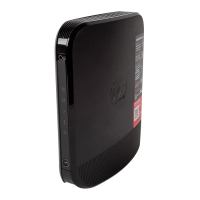17
security) devices to connect. We
strongly advise against using WEP
wireless security, due to the ease in
which someone else can breach this
security encryption.
SSID
This allows you to change the
broadcast name of you wireless
network.
Passphrase
This allows you to change the security
password for your wireless network.
Broadcast SSID
This allows you to disable broadcasting
of your SSID to aid security. When
disabled your Network will not appear
when devices scan for available
networks. These devices will have to be
manually connected.
WPS
This allows you to view your WPS pin.
This is useful when connecting devices
that allow this connection method.
Wireless Band
This allows you to select 2.4Ghz or
5Ghz modes. Selecting the 5GHz mode
may improve performance for any
wireless devices/adapters which
operate in 5GHz mode (such as the
Super Hub Wireless USB Adapter)
However any older devices (2.4GHz
only) may not be able to connect to
your wireless network when operating
in this mode.
Wireless Channel Setting
This allows you to ‘Auto detect’ or
‘Manually set’ your Super Hub’s
wireless channel. As wireless uses radio
frequencies, or channels, to transmit
from your Super Hub to your computer,
if the channel used is congested/noisy
(from neighbourhood wireless
networks using the same channel, for
example), this will affect your networks
performance.
Setting this to ‘Auto detect’ will ensure
your Super Hub scans for and uses the
cleanest wireless channel every time
you switch it on. However if you wish,
you can manually set a wireless
channel to use.
Guest Networks
This allows you to configure two
additional SSIDs (wireless network
names) and associated access
privileges for friends or family,
for example.
113775_VM_Super Hub_MainGuide_AW02.indd 17 29/10/2010 10:50

